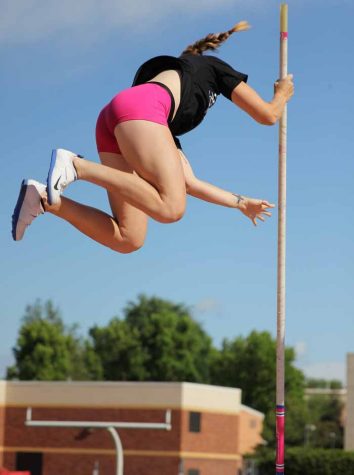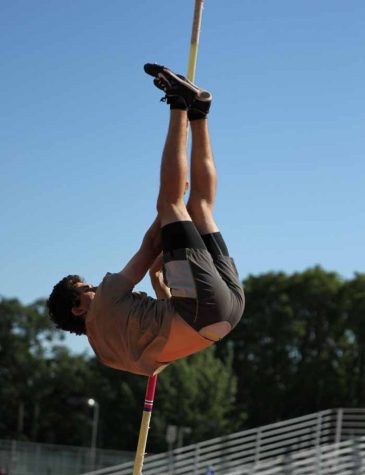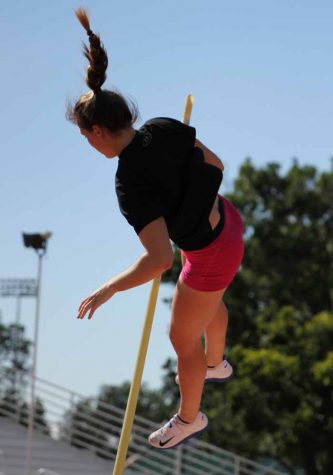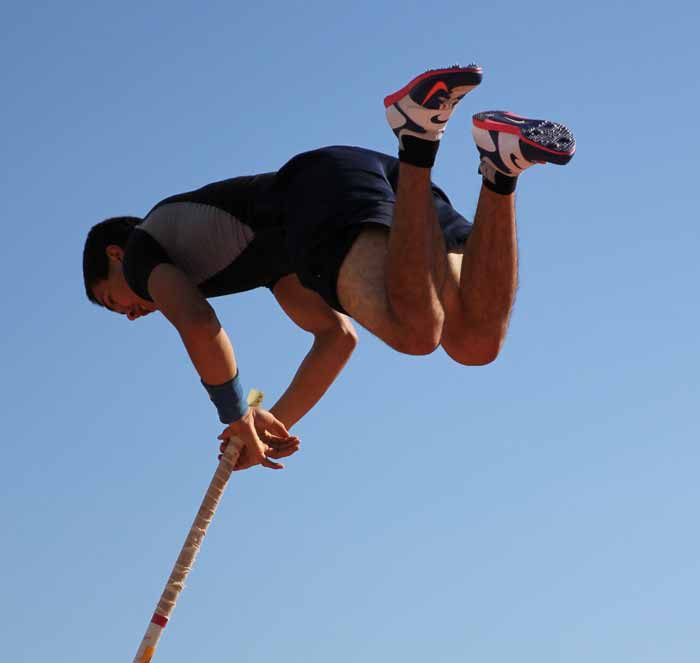Imagine running with a 10-foot pole toward a huge pit, planting the pole into the ground and propelling yourself upward to try and get over a bar that is set anywhere between 12 feet and 14 feet. All the while bending your body at a very difficult angle and trying to push the pole away from your body and the bar so you don’t knock it over. To some this may seem dangerous, scary, stupid and impossible, but to vaulters it’s all part of the fun.
Junior pole vaulter Justin Woo has been pole vaulting since his freshman year of high school and admits in the beginning it was a little frightening.
“I was really scared of it for like the first two months of my freshman year,” Woo said. “Then my coach talked to my mom and she decided she was just gonna grab me and force me to do it one day. I’m glad she did because I ended up having a lot of fun.”

It is a daunting sight to see a bar set to a height of 12 feet in the air let alone launching yourself that high, but learning how to do it helped Woo get over his fear of heights.
“I was afraid of heights when I started and I don’t think I’m as bad anymore,” Woo said.
Teammate and fellow junior pole vaulter Taylor Sack thinks it gets a bad reputation mainly for how scary it looks.
“It can be scary at times, such as when you are moving up poles,” Sack said. “If you’re smart about how you jump then it’s really not as scary as people think.”

Injuries happen all the time, and in track you’re more likely to get injured just by running than you are in pole vaulting, but people still look at vaulters like they are on a suicide mission.
“People always ask me if I want to die whenever I tell them what event I do,” Sack said. “For some reason people think that you will get impaled by the pole and that is extremely unlikely.”
In the first meet of the season, Sack qualified for nationals with a vault of 11-11 3/4, which got her first place among Division II contenders and is the fourth best in Chico State history.
Woo also finished in first place with a vault of 15-3, but hasn’t qualified for nationals yet.
Both will represent the team in the CCAA Championships May 5-7. The men’s team as a whole is ranked No.4 in nation, while the women’s team ranks fifth.

“I’m getting close. I haven’t cleared anything that high before,” Woo said.
When it comes down to it, pole vaulting is just like any other sport. As long as you are doing it the right way and using proper form, it’s really no scarier than any other event.
“If you learn it properly from the beginning and don’t do anything stupid you should be fine,” Woo said.
Jason Spies can be reached at orionsportseditor@gmail.com or @Jason_Spies on Twitter.






Sandra Giger // May 5, 2016 at 4:30 am
Jason Spies, author, if anyone misunderstands pole vault, it is you with your simplistic naive polyanna 3rd-grade journalism. You included four dazzling photos! All athletes in your photos not wearing helmets. Do you know why not? First, their coaches and schools do not encourage helmets. Beginning with the rules, from NCAA to USATF, helmets are deemed elective and optional. That is, the athlete can opt for BRAIN PROTECTION, but when you have a young kid with no role models encouraging helmets, then it’s a no brainer the peer/coach pressure let alone lack of information will never give a young kid the idea to protect himself or herself. However, (your photos don’t show) beneath the athlete how safe is the landing area?
My son, Robert Yin, died in 2010 because of a Perfect Storm of field and coaching safety hazards left unchecked. Is it “misunderstood” when the schools are really just winging it? To be clear, I mean, from lack of trainers, lack of coach oversight, poorly assembled mats and disconnected mats compirising the pit oasis landing area, defective mats that flatten to a pancake on landing, to untrained officials, to the coach’s refusal to encourage a helmet, to NO padding on the adjacent unyielding surface (i.e. asphalt) next to the pit? Since Kevin Dare from Penn State died in 2002, Penn State now requires their pole vault athletes to sign a disclaimer, saying they understand the risks, and choose to jump with or without a helmet.
But to say pole vault is fun, and to reduce the concept of danger to getting impaled by the pole, well that is so uninformed. Sure go jump, take precautions, but do so with INFORMED consent. Better yet, let that informed consent be given with the informed consent and approval of parents or guardians. And let that informed consent include a briefing of the dangers by school officials, rather than expect a minor or even under age 21 athlete to go out and do their own random research about pole vault injuries.
I miss my son, Robert Yin, who was a loyal, happy, and high energy friend, teammate, and son. He trusted the coach and school, and worse yet, he even trusted USATF and NCAA. The world needed him to live a long life, and he would have done much good for all of society.
While you are vicariously thrilled at the sight of beautiful young people flying through the air, remember, to the schools and NCAA it’s just a special interest and a business, and that if safety costs money (for cost of better facilities and training) then they will cut corners. I do not feel they cared one iota for the death of my son – or others before him. I hope someone is looking out for those kids, starting with them and their families. Not unlike how only grass roots pressure from athletes and families about post-concussion Chronic Traumatic Encepalopathy (CTE) is changing football.